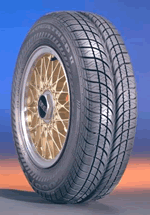|
What is Friction?
- Friction is the force between two objects as they move over one another such as a car's tire
and the surface which it is travelling on.
- There are two types of friction, only one which with we will be dealing with. These types are
known as static friction and kinetic friction. Static friction is the frictional force required to start an object moving
on another surface. Kinetic frictional force is the force to keep the object in motion.
- The force to get something moving is always greater then the force to get it moving due to
the "stickness" between the two objects while trying to move one. Once you get your car moving the tires do not need as great
of a force to keep moving.
- A value known as the coefficent of friction is the value which tells how much "stickiness"
is between the two objects.
- The force of friction is measured as the coefficent of friction multiplied by the normal
force.
- The normal force is the force of the bottom surface (such as a road) pushing up on the
other object(such as a car) as the first object (car tires) pushes down on it.
- One thing that you may not have realized is the sound caused by running one surface over another
is caused by friction. The sound made by car tires is caused by the frictional force between the rubber and the
pavement.
- This sound is caused when the two objects form and break new bonds as one object moves across
the other.
Friction and weather conditions
SNOW
As snow becomes hard and packed it can be very slippery. The coefficent of friciton
is then less then when the tires are on pavement which means that the "sticky" force is not as great holding the tires and
the snow covered road together. In these conditions the car tires begin to slip as they try to grip onto the road but the
static frictional force to get the car going is not there and as a result the car tires spin in the snow.
RAIN
When there is too much water on the road cars will hydroplan if they are going too fast. What
happens when a car hydroplans is that the water gets between the tires and the road leaving an unexistant frictional force.
The tires are not in contact with the road so the frictional force is gone causing the car to slid until the tires make contact
with something that will cause there to be a frictional force.

|
| Source:http://auto.howstuffworks.com/tire5.htm |
This tire is an example of a tire that is made for rainy conditions. The way the tire is designed
is to allow the water to go from under the wheels allowing the tire to stay in contact with the road providing the traction
needed to stay on the road.
|



